Climate News and Views
Hot Year, Cool Response -- A view of the year in climate
May 2011
The Mississippi River floods to record levels -- while the flood of climate science continues to demand action.
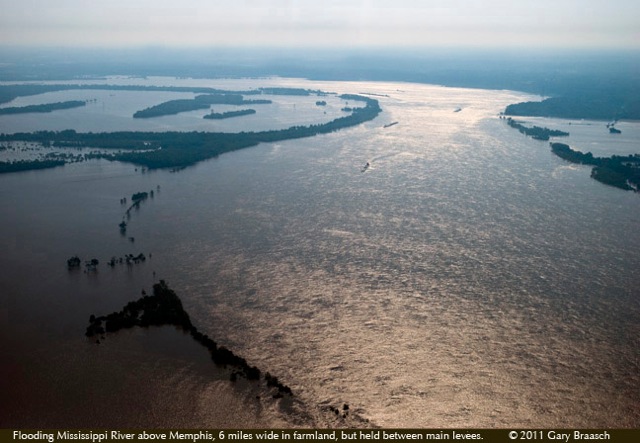
The great Mississippi River flood of 2011 is surging ever higher as it flows into the Delta. From the confluence of the Ohio River south to below Memphis, the river was above or nearly as high as the historic 1937 and 1927 floods -- the events which initiated the major levee system that protected most of the land this year. Farther down into Louisiana, the Mississippi is flooding at the highest levels ever, and the Army Corps of Engineers, keepers of the huge levee system, opened flood gates above New Orleans to lower the water there. About 114,000 cubic feet of water per second surged through the Morganza spillway into the Delta's Atchafalaya basin to the west of the main river channel, eventually to flood up to 3,000 square miles and several towns. To keep track of the flood, see NOAA's flood maps and NASA's Earth Observatory. Living on Earth has a historical view of the flood of 1927 and the levee system which the U.S. built in response.
The excellent weather analyst at Weather Underground, Jeff Masters, wrote that "flooding on tributaries feeding into the Mississippi is severe in many locations along the Mississippi, since the tremendous volume of water confined behind the levees is backing up into the tributaries. Huge quantities of farmland are being submerged in the great flood." He calculates the damages so far, from the Ohio confluence where the Army Corps of Engineers blasted open a levee to relieve Cairo, IL, down to Louisiana to be more than $2 billion. The flood is already the 10th costliest weather disaster since 1980, based on NOAA records.
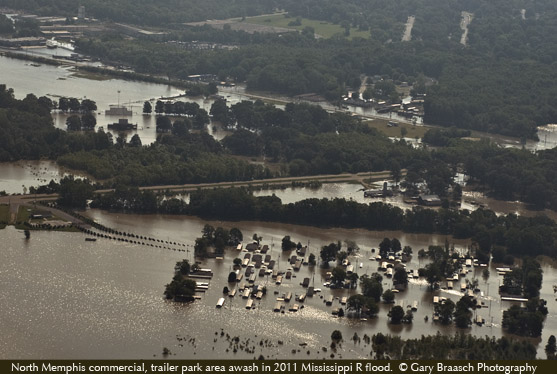
In Memphis, social, economic and immigration issues were highlighted by the flooding of many mobile home parks which are primarily inhabited by Hispanics and Mexican immigrants. The 148-house Memphis Mobile City north of downtown, for example, was evacuated and water was well above the window sills from flood water backing up into Ladd Creek. At least three other mobile parks were totally isolated by the waters. A newspaper article quoted a county official who said of the more 300 Memphis flood evacuees who moved to shelters, more than 90 percent were Hispanic, even though the county population is only six percent Hispanic. Advocates of the flood victims are questioning why homes are allowed in low areas which have repeatedly flooded in recent years, and a federal lawsuit alleges that deceptive selling by developers kept the history of flooding from many residents who do not speak English well.
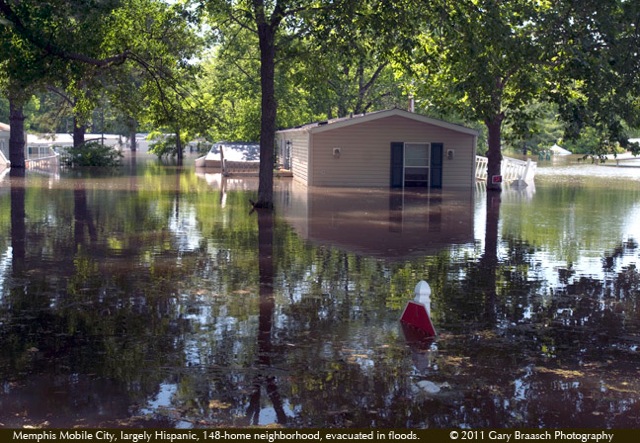
This spring already is one of the most disastrous in U.S. climate history, according to NOAA -- with record tornado swarms spawned by recurrent violent weather systems and in the Texas region severe drought making for wildfires that scorched more than twice the area of any April this century. The Mississippi River floods were created by a repeating storm track in April which, said NOAA, "tapped Gulf of Mexico moisture in a southerly surface airflow that generated storm systems week after week over the Midwest. The resulting well-above-normal rainfall culminated in widespread record flooding in the Ohio Valley by the end of the month. Some areas received up to 20 inches of rain during the month, which is nearly half their normal annual precipitation." Illinois, Indiana, Kentucky, Ohio, Pennsylvania, and West Virginia all had the wettest April on record. All this water flowed on into the Mississippi.
Scientists looking at the long-term implications of the rainfall and the recurrence of flooding on the Mississippi and other rivers are beginning to see a climate change sign. In a briefing for Congressional staff on May 9, water expert and energy and resources scientist Peter Gleick said, "Extreme weather is influenced by climate change, and extreme weather events are now subject to human influence." At the briefing (PDF), , sponsored by American Association for the Advancement of Science (AAAS) and the American Meteorological Society (AMS), Gleick pointed to the repeating occurrence of severe flooding on the Mississippi: There were two "1‐in‐500 year" flood events within a few years of each other, in 1993 and 2000 in parts of the Basin, he said, then again in 2008, and now again this year.
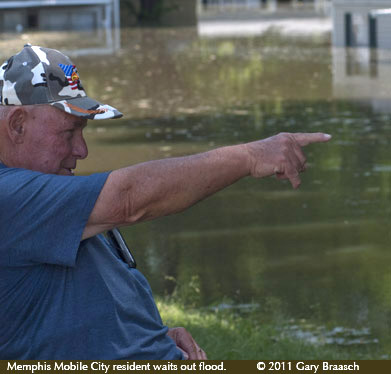
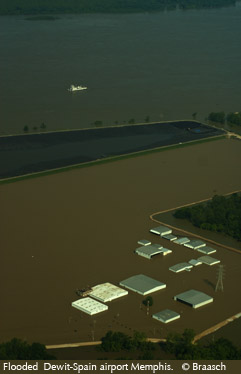
Climate change has been linked to heavier rainfall from individual storms worldwide. More specifically, a study published in Nature in February, "Human contribution to more-intense precipitation extremes," found that "human-induced increases in greenhouse gases have contributed to the observed intensification of heavy precipitation events found over approximately two-thirds ... of Northern Hemisphere land areas."
Because of this and many other research findings about the severity and acceleration of human-caused climate change, one of America's premier scientific organizations warned this week that the United States faces great risks which create "a pressing need for substantial action to limit the magnitude of climate change and to prepare for adapting to its impacts." The National Research Council's final report of a comprehensive review of climate science and possible U.S. action, which was commissioned by Congress, concluded that current efforts of local, state, and private sector actors are important, but that strong federal policies are required urgently. "The faster that greenhouse gas emissions are reduced, the lower the risks," said the report. The choices we are making today (such as to continue to build many coal fired power plants and the current drive in a GOP-lead Congress to reduce renewable energy investments), "will lock in emissions commitments for decades to come. ... The risks of continuing "business as usual" are greater than the risks associated with strong efforts to limit and adapt to climate change.... many adverse changes in the climate system would be difficult or impossible to "undo."
The report was echoed in Peter Gleick's warning that "The continued delay in taking action means we face rapidly worsening impacts, and unavoidable adaptation. We are loading the dice and painting higher numbers on them."
Greenhouse gases increase at record rate in 2010 to highest ever recorded -- Report from Mauna Loa Observatory, Hawaii
For a view of how floodplain development and changes in land use also increase flood severity, please see Nature.
COPYRIGHT NOTICE:
Photography and text Copyright © 2005 - 2017 (and before) Gary Braasch All rights reserved. Use of photographs in any manner without permission is prohibited by US copyright law. Photography is available for license to publications and other uses. Please contact requestinformation@worldviewofglobalwarming.org. View more of Gary Braasch's photography here.


